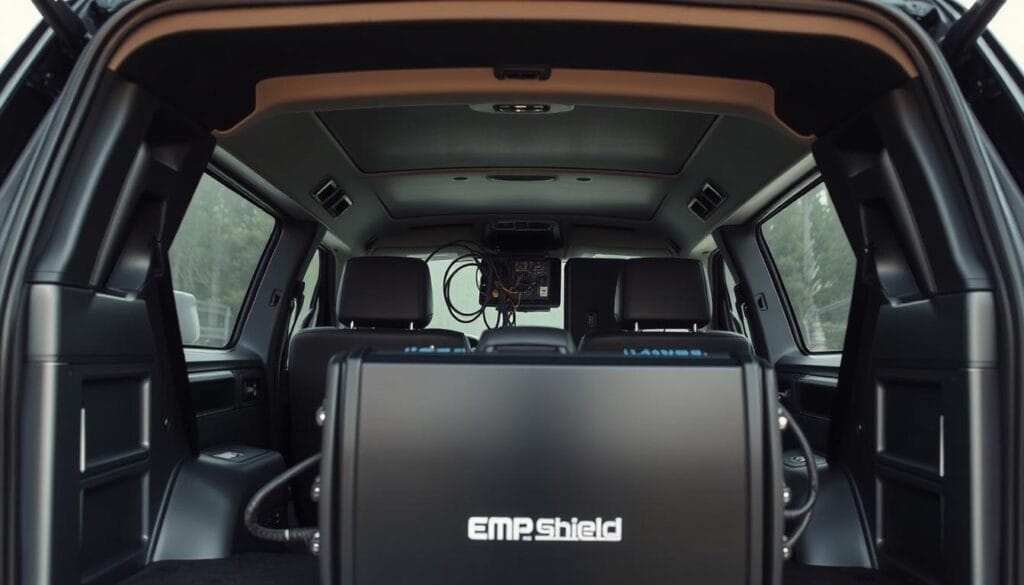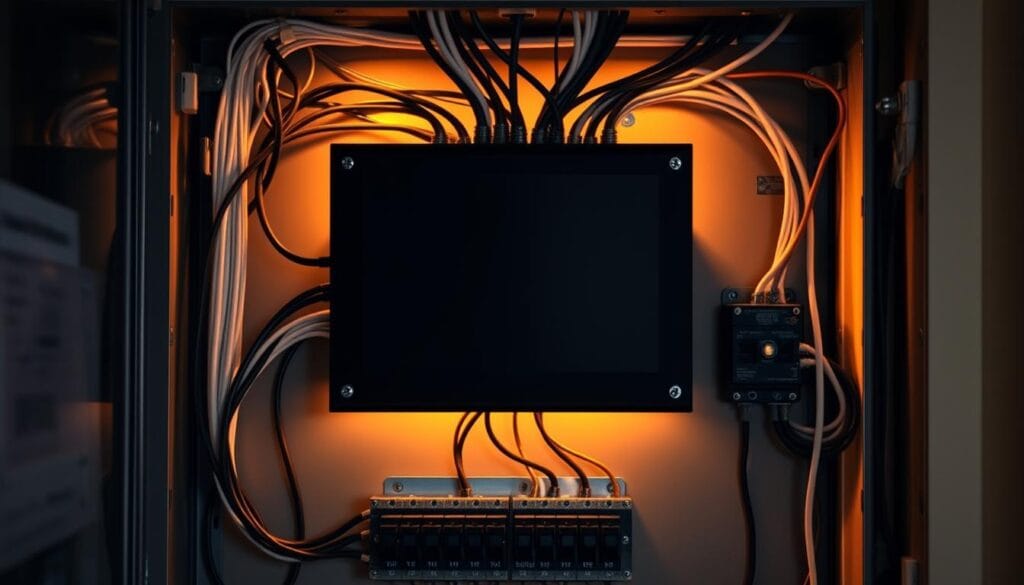What if a single surge could wipe out your home’s electronics in an instant? With threats like electromagnetic pulses, lightning strikes, and solar flares becoming more unpredictable, protecting your devices isn’t just smart—it’s urgent. That’s where EMP Shield steps in. Built to military and UL 1449 standards, this cutting-edge solution is rigorously tested at Keystone Compliance laboratory, ensuring unmatched reliability against even the most extreme scenarios.
Whether you’re safeguarding your family’s essentials or securing critical systems, EMP Shield is the top choice for defense. Its seamless integration into your home’s electrical system means peace of mind without complexity. This guide simplifies the process, combining expert insights with real-world testing data to make setup effortless for everyone.
Key Takeaways
- EMP Shield meets military-grade and UL 1449 standards for maximum reliability.
- Protects against electromagnetic pulses, lightning, and solar flare surges.
- Tested and verified at Keystone Compliance laboratory for real-world performance.
- Designed for simplicity—no technical expertise required during setup.
- Available for purchase directly through the official product page.
Understanding EMP Shield and Its Benefits
Modern electronics face invisible threats that could disrupt daily life in seconds. EMP Shield offers a scientifically backed defense against these risks, blending advanced engineering with real-world reliability.
https://www.youtube.com/watch?v=8F7uVNt0v18
How Innovation Powers Your Safety
At its core, EMP Shield uses SightSpeed™ technology to detect voltage spikes in under a nanosecond. This speed—1,000 times faster than traditional surge protectors—neutralizes threats before they reach sensitive devices. Built to military specifications, it’s been tested at Keystone Compliance laboratory to withstand 40 consecutive electromagnetic pulse events without performance loss.
Recent industry news highlights its unique design. Unlike basic surge protectors, it doesn’t just divert excess energy—it creates a balanced pathway to stabilize electrical systems instantly. This approach earned UL 1449 certification, the gold standard for surge protection devices.
Dual Defense for Peace of Mind
Two critical features make this system stand out. First, its EMP protection guards against solar flares and nuclear-induced pulses. Second, integrated lightning defense shields wiring and appliances during storms. Together, they create a comprehensive safety net for homes and vehicles.
For those seeking vehicle protection solutions, the same technology applies. Real-world testing proves it works: during simulated attacks, protected systems remained fully operational while unprotected devices failed catastrophically.
By merging instant response times with military-grade durability, EMP Shield redefines what modern protection means. It’s not just a device—it’s an essential layer of security in our electrically dependent world.
Installation guide for EMP shield on Your Vehicle
Your vehicle’s electronics face hidden dangers every time you turn the key. From alternator spikes to roadside EMP risks, proper safeguards keep critical systems running. This process combines precision with practicality, whether you drive a compact car or heavy-duty truck.

Gear Up Safely Before Starting
Always begin by disconnecting the battery. Wear insulated gloves and safety glasses. Gather these tools:
- Socket wrench set
- Wire cutters/strippers
- Zip ties
- Multimeter (optional)
Mounting and Connection Sequence
- Identify a flat surface near the battery (firewall works best)
- Measure wire lengths – keep under 18 inches when possible
- Secure red wire to battery positive (+), black to negative (-)
- Attach green ground wire to chassis bolt 4+ feet from battery
| Component | DIY Risk | Pro Installation |
|---|---|---|
| Battery Terminals | Potential spark hazard | Guaranteed secure fit |
| Grounding Point | Insufficient contact risk | UL-compliant bonding |
| Wire Routing | Chafing/heat exposure | Military-spec protection |
For visual learners, our detailed walkthrough shows each phase. Certified mechanics complete the job in 22 minutes average – consider professional help if unsure.
Installation Tips for Home, Generator, and Solar Systems
Proper setup transforms vulnerability into resilience for stationary power systems. Unlike mobile applications, home and energy installations demand careful planning due to complex wiring networks and permanent fixtures.

Wiring Precision Matters
For home systems, position the device within 5 linear feet of your main electrical panel. This reduces resistance and ensures rapid response to surges. Use copper connectors rated for 200+ amps—cheap alternatives corrode over time.
Generator setups require different strategies. Mount the unit on a dry, elevated surface away from fuel lines. Keep ground wires under 10 feet, attaching them to dedicated rods driven 8 feet deep. Solar arrays need isolation from inverter cables—maintain 18-inch separation to prevent interference.
- Secure loose wires with UV-resistant zip ties
- Label all connections for future maintenance
- Test voltage stability with a multimeter post-install
Consistency is key. Whether protecting a solar farm or backup generator, follow these practices:
| Component | Home | Generator | Solar |
|---|---|---|---|
| Ground Wire | Panel bond | Dedicated rod | Array frame |
| Cable Length | ≤5 ft | ≤10 ft | ≤15 ft |
| Separation | 6″ from pipes | 12″ from fuel | 18″ from inverters |
When integrating with existing systems, consult detailed schematics for your specific setup. Professionals recommend annual inspections to maintain peak performance—especially after extreme weather events.
Conclusion
Imagine never worrying about losing power to your most vital systems during a crisis. EMP Shield delivers peace of mind through military-grade engineering that’s been battle-tested against extreme scenarios. Whether securing your vehicle’s electronics or shielding solar arrays, this solution adapts seamlessly to diverse needs.
From quick battery-terminal connections to precise home wiring, the process prioritizes safety without complexity. Rigorous lab testing proves its ability to neutralize threats in under a nanosecond—faster than traditional protectors. This speed, paired with UL-certified durability, ensures defense against solar flares, lightning, and pulse events.
Those exploring complete protection solutions will appreciate its versatility. Generators stay operational, cars retain critical functions, and home systems remain stable—all through one trusted device. Even first-time users achieve professional results by following clear, safety-focused steps.
Don’t wait for disaster to strike. Take control with technology that’s redefined modern safety standards. Explore video guides and real-world success stories to see how quickly you can fortify your essentials.
FAQ
How does EMP Shield protect against electromagnetic pulses?
The device uses advanced filtering technology to detect and divert high-voltage surges caused by EMPs or lightning strikes. It redirects harmful energy away from sensitive electronics, keeping your systems safe.
Can I install EMP Shield on my Tesla or other electric vehicles?
Yes! It’s compatible with most electric vehicles, including Tesla models. Follow the vehicle-specific wiring guidelines in the manual, and ensure connections are made directly to the battery terminals.
Will this work with my home’s solar power setup?
Absolutely. For solar systems, install the unit close to the inverter or charge controller. Use 10-gauge wiring for optimal performance, and keep cable runs under 3 linear feet to minimize resistance.
Does it require professional installation for generators?
While DIY is possible, generators like Generac or Cummins may need certified electricians for code compliance. Always disconnect the generator’s fuel source and battery before starting the process.
What’s the difference between EMP protection and standard surge protectors?
Traditional surge protectors handle minor spikes, but EMP Shield defends against massive electromagnetic pulses—like those from nuclear events or solar storms—that can fry unprotected circuits instantly.
How do I test if my EMP Shield is functioning after installation?
Most models have LED status indicators. For advanced verification, use a multimeter to check voltage stability during simulated surges or consult the manufacturer’s troubleshooting guide.
Can one unit protect both my RV and its attached solar panels?
Yes, but ensure the combined load doesn’t exceed the device’s rated capacity. For RVs with dual battery banks, consider installing separate units for each system.
Is lightning protection included with EMP Shield models?
All units meet UL 1449 standards for surge suppression, offering defense against lightning-induced power surges. For areas prone to frequent strikes, pair it with a whole-house arrester.
What’s the warranty coverage for DIY installations?
The warranty remains valid as long as installation follows the provided instructions. Document your process with photos and save receipts in case proof is needed for claims.
